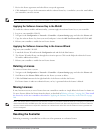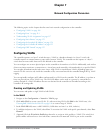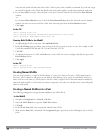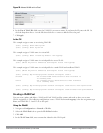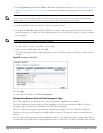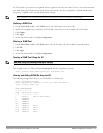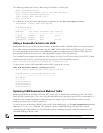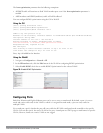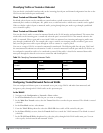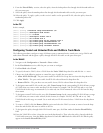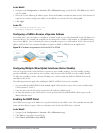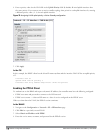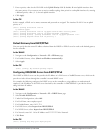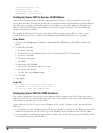
The bcmc-optimization parameter has the following exemptions:
l All DHCP traffic will continue to flood VLAN member ports even if the bcmc-optimization parameter is
enabled.
l ARP broadcasts and VRRP (multicast) traffic will still be allowed.
You can configure BCMC optimization using the CLI or WebUI.
Using the CLI
(host) (config) #interface vlan 1
(host) (config-subif)#bcmc-optimization
(host) (config-subif)#show interface vlan 1
VLAN1 is up line protocol is up
Hardware is CPU Interface, Interface address is 00:0B:86:61:5B:98 (bia 00:0B:86:61:5B:98)
Description: 802.1Q VLAN
Internet address is 10.17.22.1 255.255.255.0
Routing interface is enable, Forwarding mode is enable
Directed broadcast is disabled, BCMC Optimization enable
Encapsulation 802, loopback not set
MTU 1500 bytes
Last clearing of "show interface" counters 12 day 1 hr 4 min 12 sec
link status last changed 12 day 1 hr 2 min 21 sec
Proxy Arp is disabled for the Interface
Using the WebUI
1. Navigate to Configuration > Network > IP.
2. In the IP Interfaces tab, click the Edit button of the VLAN for configuring BCMC optimization.
3. Select Enable BCMC check box to enable BCMC Optimization for the selected VLAN.
Figure 30: Enable BCMC Optimization
Configuring Ports
Both Fast Ethernet and Gigabit Ethernet ports can be set to access or trunk mode. By default, a port is in access
mode and carries traffic only for the VLAN to which it is assigned. In trunk mode, a port can carry traffic for
multiple VLANs.
For a trunk port, specify whether the port will carry traffic for all VLANs configured on the controller or for specific
VLANs. You can also specify the native VLAN for the port. A trunk port uses 802.1q tags to mark frames for specific
VLANs, However, frames on a native VLAN are not tagged.
DellPowerConnectW-SeriesArubaOS6.2 | User Guide NetworkConfigurationParameters | 114



